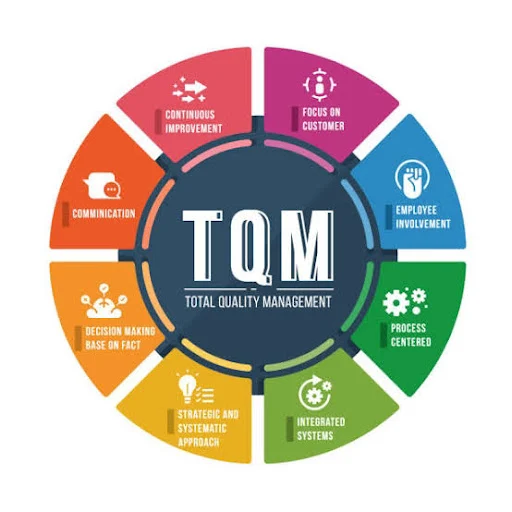Chapter 9: Quality Control and Total Quality Management (TQM)
In today's competitive industrial environment, ensuring consistent product and service quality is crucial for survival and growth. Quality Control (QC) and Total Quality Management (TQM) are strategic approaches aimed at maintaining and improving quality across all functions and processes of an organization.
9.2 Quality and Its Dimensions
Quality is the degree to which a product or service meets customer expectations. Key dimensions include:
-
Performance
-
Durability
-
Reliability
-
Conformance to standards
-
Aesthetics
-
Serviceability
9.3 Quality Control (QC)
Quality Control is the process of identifying defects in products and processes to ensure conformance with specified quality standards.
9.3.1 Objectives of QC
-
Detect and eliminate defects
-
Maintain consistent product quality
-
Reduce waste and rework
-
Improve customer satisfaction
-
Ensure compliance with standards
9.3.2 Tools of QC
-
Control Charts – Monitor process variation
-
Cause-and-Effect Diagram (Ishikawa or Fishbone) – Identify root causes of defects
-
Histogram – Show frequency distribution of data
-
Pareto Analysis – Focus on major problems (80/20 rule)
-
Scatter Diagram – Identify correlation between variables
-
Check Sheet – Collect data in real-time
-
Flowchart – Visualize process flow
9.4 Statistical Quality Control (SQC)
SQC uses statistical techniques to control and improve quality.
9.4.1 Types
-
Descriptive Statistics – Mean, range, standard deviation
-
Acceptance Sampling – Inspect a sample to decide on the whole lot
-
Process Control – Monitor ongoing production using control charts
9.5 Total Quality Management (TQM)
TQM is a holistic approach to long-term success through customer satisfaction. It involves all members of the organization participating in improving processes, products, services, and culture.
9.5.1 Principles of TQM
-
Customer-focused
-
Continuous improvement
-
Employee involvement
-
Process-centered approach
-
Integrated system
-
Strategic and systematic approach
-
Decision-making based on facts
-
Effective communication
9.6 TQM Tools and Techniques
-
Kaizen (Continuous improvement)
-
5S (Sort, Set in order, Shine, Standardize, Sustain)
-
Benchmarking – Comparing with best practices
-
Six Sigma – Reduce variation and defects
-
Quality Circles – Small group of workers solving quality problems
-
PDCA Cycle (Deming Cycle) – Plan, Do, Check, Act
9.7 Benefits of Quality Management
-
Improved customer satisfaction
-
Increased efficiency and productivity
-
Reduction in costs due to less rework and waste
-
Enhanced employee morale and teamwork
-
Better market reputation and profitability
9.8 Quality Certifications
-
ISO 9001 – International standard for quality management systems
-
Six Sigma Certification – Belt levels (Yellow, Green, Black, etc.)
-
CE Marking, BIS Certification, etc. – Product compliance in specific markets
Conclusion
Quality Control and TQM are essential for ensuring consistent performance, reducing errors, and satisfying customer needs. While QC focuses on defect detection and correction, TQM emphasizes preventing defects through continuous improvement involving everyone in the organization.
Exercises
A. Short Answer Questions
-
Define quality control.
-
What are control charts used for?
-
List the 7 basic quality tools.
-
What is Kaizen?
B. Long Answer Questions
-
Differentiate between Quality Control and Total Quality Management.
-
Explain the principles of TQM and how they contribute to organizational success.
-
Describe the seven basic tools of quality control with examples.
-
What is the role of Six Sigma in quality improvement?
C. Multiple Choice Questions
-
Pareto analysis is based on:
a) 70/30 rule
b) 90/10 rule
c) 80/20 rule
d) 60/40 rule -
The first step in the PDCA cycle is:
a) Act
b) Check
c) Do
d) Plan -
ISO 9001 certification is related to:
a) Safety
b) Environment
c) Quality
d) Finance
Answers: 1–c, 2–d, 3–c
D. Practical Task
Visit a local manufacturing unit or service organization and prepare a report on how quality is managed there. What tools are used? Are there any certifications like ISO 9001 or Six Sigma?

Comments
Post a Comment
"Thank you for seeking advice on your career journey! Our team is dedicated to providing personalized guidance on education and success. Please share your specific questions or concerns, and we'll assist you in navigating the path to a fulfilling and successful career."